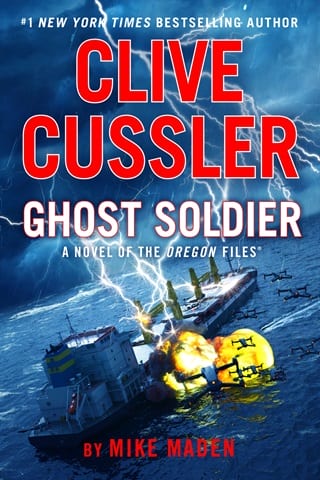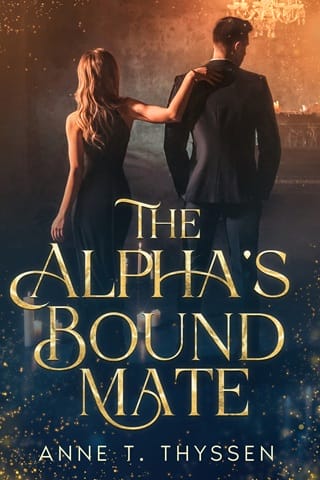Chapter 71
71
Cabrillo marched into the conference room and fell into one of the chairs. Max and Murph did the same. Eric was already seated in front of a laptop and projecting Juan's Midjourney-generated image of the Vendor onto one of the wall screens. It looked just like an actual color photograph of the man, but it was entirely fictional, a product of Juan's prodigious memory married to digital artistry.
"What've you got for us, Stoney?" Juan asked.
"That's the picture you and the Magic Shop came up with for the Vendor. We've scoured every social media source we know, but couldn't find a match. Not in company records, school yearbooks, nothing. If he ever had a digital shadow, he found a way to completely erase it."
"Another dead end?"
Eric smiled. "Until we found this."
He pulled up a black-and-white image from old film stock, grainy and damaged. The man's face was bearded, his almond-shaped eyes covered by round, steel-rimmed glasses from the period. Stone had wire-framed the digitized image, cropped it, and re-angled the man's face to match the approximate profile angle of the Vendor.
"Whoa," Max said. "Two peas in a pod."
"Just wait." Eric punched a couple of keys. The Midjourney image was made slightly transparent, then Stone superimposed it upon the black-and-white image. They were practically identical, down to the arrogant, thin-lipped smile.
"Unless our nemesis is a time traveler, I'm guessing that's a relative," Murph said. "Though I kinda like the idea we're looking at Dr. Who."
Juan leaned forward on his elbows studying the image.
"Who is it?"
"That's Dr. Yoshio Mitomo. He was head of the virology lab inside of Unit 731."
"The infamous prison camp the Japanese ran in Manchuria during the war," Max said. "The human experiments they did there were beyond the pale. Worse than Auschwitz."
"And some of those experiments were conducted on American soldiers, especially airmen," Murph said. "They demonized our bomber pilots as war criminals unworthy of humane treatment."
Max stabbed a finger at Mitomo's image. "That's a bona fide war criminal. A firing squad was too good for him."
"Unfortunately not," Eric said. "We captured Mitomo after the war. We knew what he was up to at Unit 731. But the OSS swept him up in Operation Paperclip. Offered him immunity in exchange for his services."
"They should've hanged him," Max said.
"Truman was more worried about world revolution than international justice," Juan said. "We were looking for every material and technological advantage to stop the spread of Stalin's evil. We were in a race to capture as many German and Japanese scientists as we could before the Russians scooped them up. It was a kind of arms race, only it was about capturing the brains that would develop the next generation of warfare."
"I understand it," Max said. "But I still don't like it. We should've lined them all up against the wall."
"Then we might not have gone to the moon," Murph said. "Wernher von Braun practically built the Apollo program. Same story on the Russian side. Every Soviet space rocket should've had ‘Made in Germany' stamped on its backside."
"Enough with the history lessons," Juan said. "What happened to Mitomo?"
"He disappears from any official record after 1946. Well, except for this." Eric pulled up a black-and-white picture of a baby Japanese girl.
"Mitomo's daughter?" Juan asked.
"Yes. And fast-forward to this." Eric's fingers flew across his keyboard. A Japanese marriage certificate, a faded color wedding photo, and a local Japanese newspaper clipping appeared. The Cray supercomputer had translated all of it.
"Mitomo's daughter marries a man named Tomoyuki Hashimoto. He was a Japanese aerospace engineer. He was a salary man, and an alcoholic according to his medical records." Eric pulled up a coroner's report. "Committed suicide in 1994 after he was fired from the F-2 fighter program." Eric tossed in a photo of the jet plane.
"The Viper Zero," Murph said. "An F-16 derivative. Made by Mitsubishi."
Cabrillo was always amazed at Murph's encyclopedic knowledge of all things weapons related, even systems from before his time.
"And the key word is ‘Mitsubishi,'" Eric said.
"As in Mitsubishi Zero, the famous Japanese fighter plane of World War II?" Max asked.
"No. Mitsubishi as in the J8MI Shusui."
"Japan's first jet fighter," Murph said. "A German Komet knockoff."
"What's this got to do with the Vendor?"
"One of the lead engineers for the J8MI was Hiroshi Hashimoto, Tomoyuki's father."
"I can see where this is going," Juan said. "And I'm getting a sick feeling."
"You're stomach is on point, Chairman. A wartime medical researcher and a wartime aircraft designer combine their gene pools to create the ultimate weapon of mass destruction, their grandson, the Vendor."
"We still don't have a name."
"Oh, but we do." Eric zoomed in on another Japanese document. "This is the koseki —the family register of the Hashimoto family." Stone then circled a handwritten name in faultless kanji script. "That's the name of Tomoyuki's only son, Shigeru Hashimoto, aka the Vendor."
"What do we know about him?"
"He was a weapons designer for Japan's largest defense contractors before joining the Acquisition, Technology & Logistics Agency, Japan's version of DARPA. A brilliant visionary. Pushed hard against the conventions. But you know what they say in Japan? ‘The nail that sticks out gets hammered.' It's not clear whether he was fired or quit. What is clear is that he disappeared shortly thereafter and presumed a suicide, like his father."
"A fatal presumption," Max said. "In more ways than one."
"So we have a name and a face. Where can we find him?"
"I hit all kinds of dead ends. After his presumed suicide, he disappears from any records. So I decided to go back to the source material and dig around. I don't have any proof of anything, but sometimes circumstantial evidence is enough to convict."
"You got that from Murder, She Wrote , didn't you?" Murph said.
"Guilty as charged."
"Let's cut to the chase," Juan said. A lack of sleep and a growing sense of urgency had shortened his fuse.
"Two things. First, it turns out Grandpa Mitomo was involved with a program called Operation Black Chrysanthemum."
"Never heard of it," Juan said. "There was an Operation Cherry Blossoms at Night. It was a plan to use a seaplane from an I-400 Japanese submarine to attack San Diego with biological weapons from the air."
"Bingo. This was a parallel program. Only Black Chrysanthemum wasn't aimed at San Diego. It was aimed at Guam."
Max frowned. "Why Guam?"
"Guam was the base for B-17s and B-29s bombing Japan. Japanese fighters couldn't stop the American bombers, so the military hatched a plan to neutralize it with neurological agents."
"What happened to the operation?" Max asked.
"Just like with Cherry Blossoms. Both submarines were sunk before they reached their targets."
"So if we connect the dots, Hashimoto is planning on some kind of biological weapons attack on a U.S. military base," Juan said. "But which one?"
"Could be anywhere," Murph said. "The DoD maintains at least seven hundred fifty bases in eighty countries. In Asia, there are a hundred twenty bases in Japan. Seventy-three in South Korea."
"He wouldn't hit a base in Japan, would he?" Max asked.
"Depends on how angry he is," Eric said. "Or why. No telling what his motives are."
"Motive is the key," Juan said. "We can't read his mind. But maybe he's following a familiar pattern. What if he was planning an attack on Guam, just like his grandfather did?"
"With a submarine?" Max asked. "And neurotoxin?"
"Not just any submarine. But a sub that can launch missiles or even planes."
"Or drones," Murph added. "He seems to favor those."
"We should alert the authorities on Guam," Max said.
"And tell them what? Get ready for a possible attack at an unknown time by a still unknown person with unknown weapons? And what if we're wrong? What if it's South Korea? Or somewhere else? Do we alert all seven hundred fifty American bases ‘just in case'?"
"I see your point."
"I bet every military base in the Asian theater is on full alert anyway after the sinking of that South Korean destroyer."
"And for all we know," Eric added, "he's conspiring with the Chinese and their Taiwan operations. He might be targeting fleets instead of islands."
"I actually hope it is Guam," Murph said.
Max leaned forward. "Why?"
"Their new air defense system comes online day after tomorrow. It's the latest and greatest, like Iron Dome on steroids. Nothing the Vendor can throw at it will get through."
"Unless he attacks before then," Juan said.
"Good point. But that's assuming he knows that's the timeline," Murph said.
"If we do," Eric said, "he does. Count on it."
"I'd feel better if we told Guam to stay extra frosty for the next forty-eight hours," Max said.
Juan nodded. "Agreed. Make the call."
Murph shrugged. "I think the greater likelihood is that Guam's new air defense means he'll be looking for an easier nut to crack."
"You could be right, Wepps," Juan said. "Guam is as good a guess as any, but it's just that—a guess. So forget the target. We need to find Hashimoto."
"I might have found him," Eric said. "We finally cracked the encryption on one of the recovered phones—that Plata guy who ran the show on Sorrows."
"Outstanding. Keep going."
"Plata's phone only communicated with one satellite number. The Cray was able to track the movements of Hashimoto's phone. The main item of interest is this…"
Eric pulled up a map detailing all of the Vendor's phone locations as red dots. But one location in particular had the highest concentration of red dots. It was an island in the Bismarck Sea.
"The name of the island is Pau Rangi. We think that might be his base of operations."
"Any chance his phone is pinging there right now?" Max asked.
"It hasn't broadcast since we leveled Sorrows."
"Anything else tie him to the island?" Juan asked.
"Turns out, the Imperial Japanese Navy operated out of there during the war. An Australian Army unit was sent there in early '46 to search for holdouts, but all they found was a few abandoned bunkers and a burned-out fishing village. The Aussies wrote it off as a worthless rock. A Japanese family reclaimed ownership in 1947. In 2009, the family sold it to a private real estate investment firm for tourist development."
"Please tell me that Hashimoto's name pulls up in all of this."
"No such luck. The name of the family that originally owned the island is Onizuka. The real estate outfit they sold it to is a shell corporation. Hashimoto's name hasn't turned up in any of the documents, but it's a pretty good bet he's connected to it somehow."
Juan studied the map, his chin perched in his clenched hands.
"You're right, Stoney. It's all circumstantial. But it's the best we've got. Good work."
"Thanks."
Juan stood. "Unless someone has a better idea, we'll set a course for Pau Rangi—flank speed."
 Fullepub
Fullepub 



